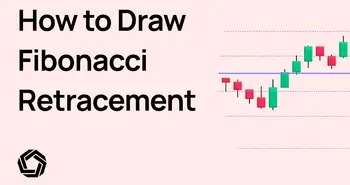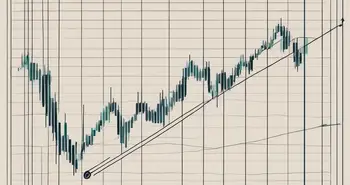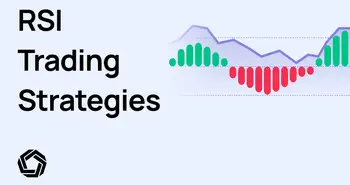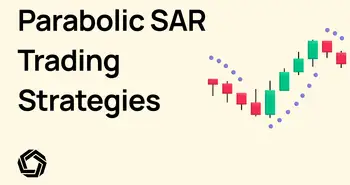Fibonacci Retracement Strategies
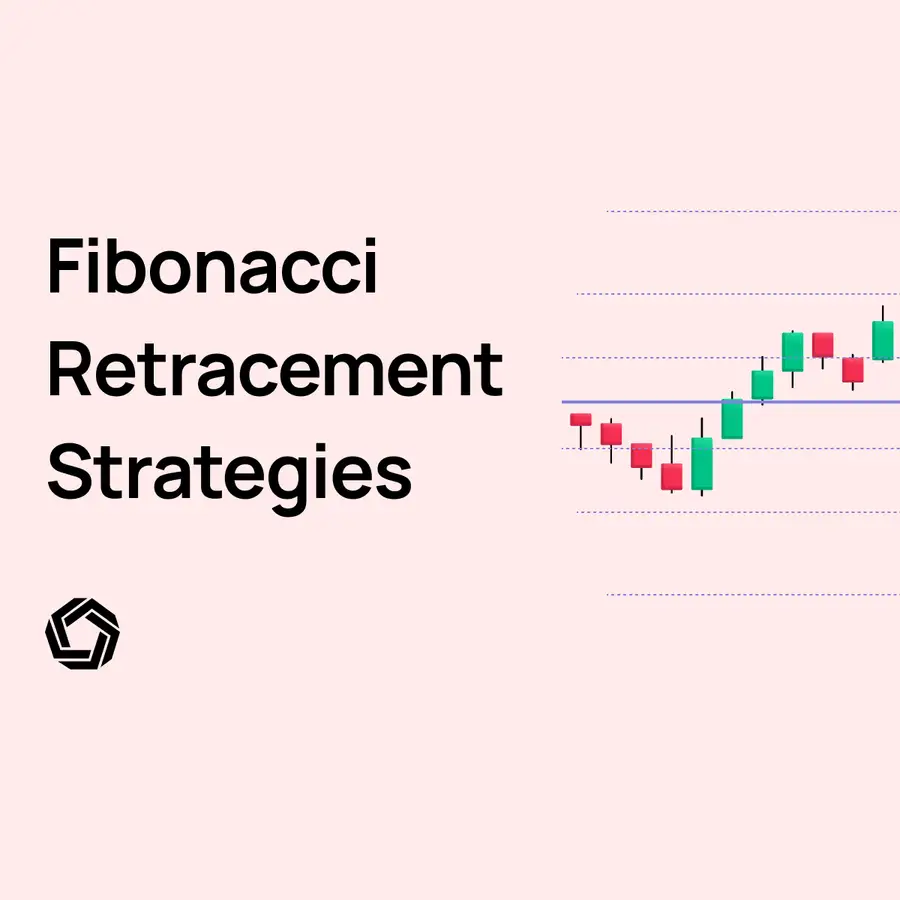
In this article, we will be discussing Fibonacci Retracement Strategies and how they can be utilized in technical analysis to identify potential price movements in the market. Unlike what the name suggests, Fibonacci Retracement has nothing to do with mathematics and everything to do with trading.
Fibonacci Retracement is a well-known technical analysis tool that measures the potential retracement levels of a stock or market by plotting horizontal lines across the vertical axis. These lines represent levels at which a potential price reversal or breakout may occur and can help you identify opportunities to buy or sell.
Throughout this article, we will be examining the mechanics of Fibonacci Retracement and how it can be used in real-life trading scenarios. We will also be providing two distinct strategies that you can use to incorporate Fibonacci Retracement into their analysis. By the end of this article, you will have a comprehensive understanding of how to use Fibonacci Retracement to improve your trading strategy.
Understanding Fibonacci Retracement
If you're fascinated by the world of technical analysis, you'll be excited to learn about the Fibonacci Retracement strategy. This powerful tool can be used to predict potential price movements in any market, and it's based on a natural sequence found in many aspects of nature.
The Fibonacci sequence is a series of numbers in which each number is the sum of the two preceding numbers.
Reproduced below are the first computed numbers in the Fibonacci sequence:
0, 1, 1, 2, 3, 5, 8, 13, 21, 34, 55, 89, 144, …
This sequence can be seen in the branching of trees, the spiral of seashells, and the pattern of a nautilus shell. As the great mathematician Leonardo da Vinci, who used the golden ratio, a ratio of the Fibonacci sequence, in his paintings, once said, “The smallest fathomable unit of the spiral is not an atom, but a whole universe.” The golden ratio also plays an important role in modern mathematics in fields such as fractals, the study of chaos, and dynamical systems.
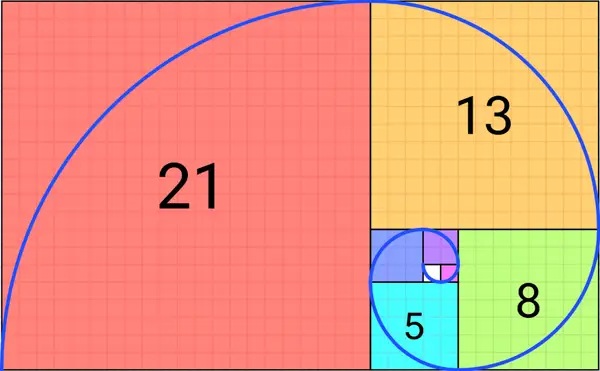

But what exactly is the Fibonacci Retracement strategy? Put simply, it's a tool that helps you identify potential levels of support and resistance in a market. These levels are determined by plotting horizontal lines across the vertical axis of a chart based on key swing high and swing low points. The most important Fibonacci retracement levels are 38.2%, 50%, and 61.8%, although other levels can also be used depending on the specific market and trading strategy. So make sure to exclude the other levels in the settings if you do not need them.
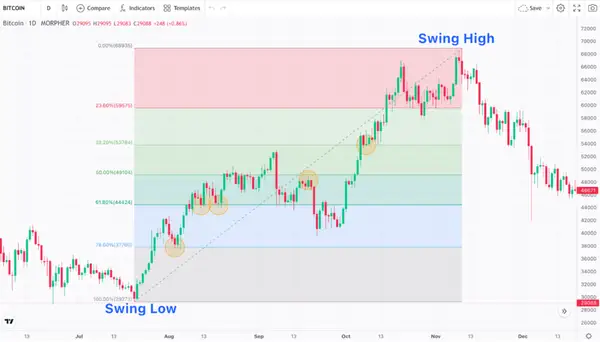
To use Fibonacci Retracement in your trading, you first need to identify the key swing high and swing low points in a chart. The swing high point is the highest point in a trend, while the swing low point is the lowest point. Once you have these points, you can use the Fibonacci retracement levels to identify potential support and resistance levels. We highlighted some key moments with an orange circle on the charts, where the price bounced off the support or the resistance. If the price of an asset falls to a Fibonacci retracement level, it may bounce back up, providing a buying opportunity. Conversely, if the price of an asset rises to a Fibonacci retracement level, it may drop back down, providing a selling opportunity.
It's important to note that Fibonacci Retracement is not infallible and should be used with other technical and fundamental analysis tools when making trading decisions. False signals can occur, particularly in choppy or range-bound markets.
Overall, Fibonacci Retracement is a powerful tool that can be used in any market, from stocks to cryptocurrencies to commodities. As the great mathematician and scientist Johannes Kepler once said, “Nature uses as little as possible of anything.” With Fibonacci Retracement, you can use the power of nature to make informed trading decisions.
Fibonacci Retracement Strategies
Momentum Strategies with Fibonacci
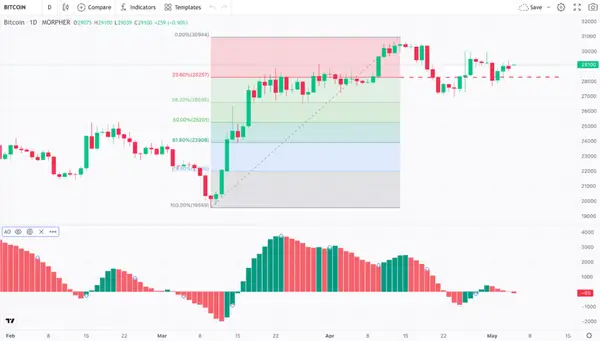
The following strategy combines the use of Fibonacci levels and the Awesome Oscillator indicator to capture market momentum and make profitable trades across various asset classes. To illustrate this strategy, we will examine the price movements of Bitcoin on a live trading chart.
When the price of an asset tests support or resistance levels, a potential breakout or reversal may be imminent. In such cases, drawing Fibonacci retracement levels can help identify potential price channels and key levels. By combining Fibonacci levels with the Awesome Oscillator indicator, you can gain additional insight into market momentum and the potential direction of future price movements.
The Awesome Oscillator is a technical analysis indicator that measures the momentum of an asset by comparing its 34-period and 5-period simple moving averages. The indicator generates buy and sell signals based on the crossing of the zero line. When the bars of the Awesome Oscillator are above the zero line, it is an indication of bullish momentum, while bars below the zero line indicate bearish momentum. The color of the Awesome Oscillator candles indicates whether they are bullish (green) or bearish (red). A bullish candle is generated when the current period's midpoint price is higher than the midpoint price of the previous period, while a bearish candle is generated when the current period's midpoint price is lower than the midpoint price of the previous period. The larger the candle, the stronger the momentum. Therefore, green candles growing in size indicate increasing bullish momentum, while red candles growing in size indicate increasing bearish momentum.
In the case of Bitcoin, we can observe a sharp move from a session low of approximately 19550 to a session high of around 31000, creating a new channel for prices. The move occurred at a fast pace, and the current price is consolidating around the 23.6% Fibonacci level. When the market exhibits such consolidation, a significant price move may be expected in the near future, as the price may either break down from the session high or move upward to new highs.
To take advantage of this potential opportunity, we can closely monitor the 23.6% Fibonacci level, as it will likely be a key support or resistance level in the future. However, before taking any trade positions, we need to analyze the Awesome Oscillator indicator, which shows the strength of market momentum and potential volume in the market.
Currently, the Awesome Oscillator is showing low candles, indicating low volume and a lack of significant market movement. Therefore, it is not advisable to take a trade at this time. However, once the price moves below the dotted line of the 23.6% Fibonacci level and the candles of the Awesome Oscillator turn downward and increase in size, a short position can be considered. Conversely, if the candles turn upward, become green and increase in size, a long position can be opened, as it is likely that the resistance at 31000 will be broken and new price highs will be created.
Overall, this strategy provides a reliable and effective approach to trading that can be applied to various asset classes. Combining Fibonacci retracement levels with the Awesome Oscillator indicator lets you capture market momentum and make informed trading decisions.
Trading Rules:
- Draw the Fibonacci Levels for the current trend
- Look for the price to go below the 23.6% level or break the resistance to create a new high
- Look for big candles and color in the Awesome Oscillator to anticipate the direction
- Once you have the break of the Fibonacci Level, take the long or short position depending on the direction of the Awesome Oscillator
Trend Reversal with Fibonacci Levels
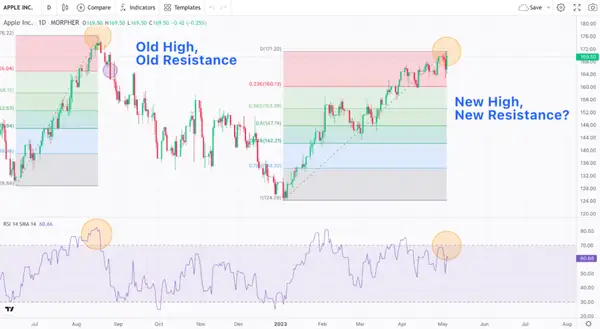
The second strategy involves pairing the Fibonacci retracement levels with the Relative Strength Index (RSI) indicator to identify potential trend reversals. The RSI indicator compares an asset's average gains and losses over a specified time frame and provides a reading between 0 and 100. By identifying overbought and oversold conditions, the RSI indicator is a useful tool in identifying potential price reversals. A reading above 70 indicates overbought conditions, while a reading below 30 indicates oversold conditions. When combined with the Fibonacci levels, this strategy can be applied to a variety of assets.
To demonstrate this strategy, let us consider the example of Apple's stock chart. Starting with the old trend, we drew the Fibonacci levels from the old low, which was around 128. As the RSI goes above 70, we start looking for new tops to identify potential price reversals. A price reversal would occur if the price did not break the resistance level (old high) we drew. Once a clear price reversal occurs and the RSI moves down again, it is optimal to open a short position with a stop-loss slightly above the resistance level. Additionally, a drop in price off the first Fibonacci level of 23.6% or further down could serve as a good indicator. If the price does not find support at this level and breaks down further, a short opportunity arises, as highlighted by the purple circle.
In the live scenario, the price is currently at a new high in the recent trend, but we do not take a short yet as the RSI does not indicate that the stock is oversold. We monitor the trend a bit longer and wait until the RSI moves above 70. Once this happens, a new high and a new resistance level will most likely emerge. At this point, we look for a reversal in the RSI and a confirmation from the Fibonacci levels that the price could not break the new resistance level. Once these conditions are met, we take a short position.
In summary, combining the RSI indicator with the Fibonacci retracement levels allows you to identify potential trend reversals and take advantage of trading opportunities. This strategy is not a standalone approach but rather should be used in conjunction with other indicators for a more comprehensive analysis of the market. As Ralph Nelson Elliott once said, “The Fibonacci sequence is as much a part of the structure of the universe as atoms, molecules, and crystals. Like everything in nature, it has its own flow and rhythm.” By understanding this flow and rhythm, you can make better-informed decisions and increase your chances of success in the market.
Trading Rules:
- Look for RSI Above 70
- Draw Fibonacci Levels for the new high
- Confirm that the price does not break the new resistance
- Once the price breaks down and RSI goes down, go Short
Conclusion
In summary, Fibonacci retracement levels are not a standalone trading strategy but rather a tool to be used in conjunction with other indicators to identify key price levels and potential market trends. In this article, we have presented two main strategies that involve the use of Fibonacci retracement levels alongside other indicators like the Awesome Oscillator and RSI. Leonardo Pisano, also known as Fibonacci, once said, “Numbers rule the universe,” By understanding these key levels, you can make more informed decisions and increase your chances of success in the market.
As with any trading strategy, it is important to remain adaptable and unemotional in the face of the market's unpredictability. As Jack D. Schwager famously noted, “The markets are the great equalizer,” and you must be swift and decisive in your pursuit of profits. By using Fibonacci retracement levels in conjunction with other indicators, you can adapt to the market's movements and achieve their financial goals. We encourage you to try these strategies on Morpher and see the results yourself. Be the nimble hunter the market requires, and the rewards will surely follow.

Disclaimer: All investments involve risk, and the past performance of a security, industry, sector, market, financial product, trading strategy, or individual’s trading does not guarantee future results or returns. Investors are fully responsible for any investment decisions they make. Such decisions should be based solely on an evaluation of their financial circumstances, investment objectives, risk tolerance, and liquidity needs. This post does not constitute investment advice.

Painless trading for everyone
Hundreds of markets all in one place - Apple, Bitcoin, Gold, Watches, NFTs, Sneakers and so much more.

Painless trading for everyone
Hundreds of markets all in one place - Apple, Bitcoin, Gold, Watches, NFTs, Sneakers and so much more.

